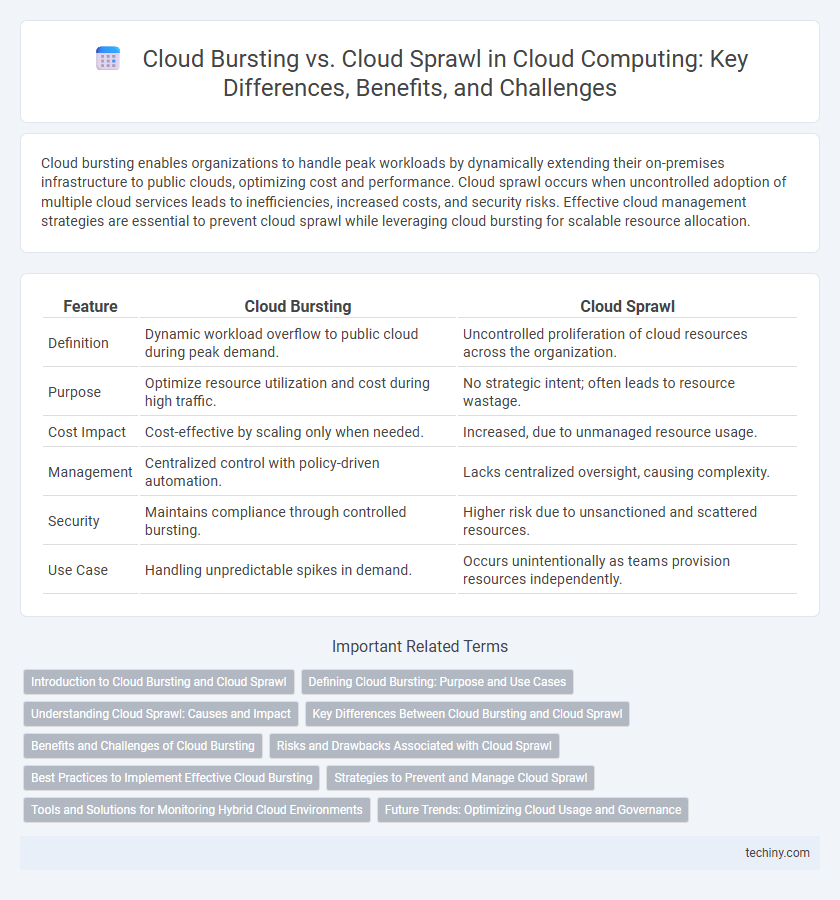Cloud bursting enables organizations to handle peak workloads by dynamically extending their on-premises infrastructure to public clouds, optimizing cost and performance. Cloud sprawl occurs when uncontrolled adoption of multiple cloud services leads to inefficiencies, increased costs, and security risks. Effective cloud management strategies are essential to prevent cloud sprawl while leveraging cloud bursting for scalable resource allocation.
Table of Comparison
| Feature | Cloud Bursting | Cloud Sprawl |
|---|---|---|
| Definition | Dynamic workload overflow to public cloud during peak demand. | Uncontrolled proliferation of cloud resources across the organization. |
| Purpose | Optimize resource utilization and cost during high traffic. | No strategic intent; often leads to resource wastage. |
| Cost Impact | Cost-effective by scaling only when needed. | Increased, due to unmanaged resource usage. |
| Management | Centralized control with policy-driven automation. | Lacks centralized oversight, causing complexity. |
| Security | Maintains compliance through controlled bursting. | Higher risk due to unsanctioned and scattered resources. |
| Use Case | Handling unpredictable spikes in demand. | Occurs unintentionally as teams provision resources independently. |
Introduction to Cloud Bursting and Cloud Sprawl
Cloud Bursting enables organizations to handle sudden spikes in workload by dynamically extending their on-premises infrastructure to a public cloud, optimizing resource utilization and cost efficiency. Cloud Sprawl refers to uncontrolled growth of cloud resources, where multiple unmanaged cloud instances lead to increased complexity, higher costs, and security risks. Understanding the balance between Cloud Bursting as a strategic scalability solution and Cloud Sprawl as an operational challenge is essential for effective cloud resource management.
Defining Cloud Bursting: Purpose and Use Cases
Cloud bursting is a hybrid cloud deployment model that enables an application to run in a private cloud or data center and seamlessly "burst" into a public cloud when demand spikes, ensuring scalability and cost-efficiency. It is primarily used for handling unexpected workload surges, disaster recovery scenarios, and development/testing environments where resource elasticity is critical. This approach prevents overprovisioning in private infrastructure while leveraging the public cloud's virtually unlimited resources on-demand.
Understanding Cloud Sprawl: Causes and Impact
Cloud sprawl occurs when an organization's adoption of cloud services leads to inefficient, uncontrolled expansion of resources across multiple platforms and accounts, often without proper governance. This uncoordinated growth results in increased IT costs, security vulnerabilities, and management complexities due to redundant or underutilized cloud resources. Understanding cloud sprawl is critical for optimizing cloud infrastructure, ensuring compliance, and maintaining operational efficiency in dynamic cloud environments.
Key Differences Between Cloud Bursting and Cloud Sprawl
Cloud bursting enables seamless scaling of applications by dynamically allocating additional cloud resources when on-premises infrastructure reaches capacity, ensuring cost-efficiency and performance optimization. In contrast, cloud sprawl refers to the uncontrolled proliferation of cloud resources and services across an organization, leading to inefficiencies, increased costs, and complex management. Key differences include cloud bursting's intentional, demand-driven resource allocation versus cloud sprawl's unmanaged, often redundant resource expansion.
Benefits and Challenges of Cloud Bursting
Cloud bursting enables on-demand scalability by extending local workloads to public clouds during peak usage, optimizing resource efficiency and cost management. Benefits include enhanced flexibility, reduced infrastructure investments, and improved application performance under variable loads. Challenges involve complex integration, potential security risks, and the need for robust network connectivity to ensure seamless workload migration.
Risks and Drawbacks Associated with Cloud Sprawl
Cloud sprawl increases security vulnerabilities by expanding the attack surface across unmanaged and under-monitored cloud resources, leading to potential data breaches and compliance issues. It causes inefficient resource utilization, resulting in inflated operational costs due to redundant and idle cloud services. Managing decentralized cloud environments complicates governance and visibility, making it difficult to enforce security policies and optimize performance.
Best Practices to Implement Effective Cloud Bursting
Implementing effective cloud bursting requires dynamic workload management to seamlessly extend on-premises infrastructure to public clouds during peak demand, minimizing latency and cost. Leveraging automated orchestration tools and real-time monitoring ensures optimal resource allocation, preventing overprovisioning that leads to cloud sprawl. Establishing clear governance policies and continuous performance analytics enhances scalability while maintaining security and compliance across hybrid environments.
Strategies to Prevent and Manage Cloud Sprawl
Effective strategies to prevent and manage cloud sprawl include implementing centralized cloud cost management tools that provide visibility into resource usage and spending across multiple cloud environments. Enforcing policies for resource provisioning, such as automated tagging and regular audits, helps ensure only necessary instances are active and reduces redundant or idle assets. Adopting cloud-native governance frameworks, like AWS Control Tower or Azure Policy, streamlines compliance and enforces organizational standards to maintain control over expanding cloud resources.
Tools and Solutions for Monitoring Hybrid Cloud Environments
Effective monitoring tools for hybrid cloud environments address challenges posed by cloud bursting and cloud sprawl by providing real-time visibility and resource optimization. Solutions like VMware vRealize Suite, Microsoft Azure Arc, and Google Anthos enable centralized management, automated scaling, and cost control across on-premises and multiple cloud platforms. These tools enhance performance monitoring, security compliance, and capacity planning to prevent resource inefficiencies and unexpected expenses.
Future Trends: Optimizing Cloud Usage and Governance
Future trends in cloud computing emphasize optimizing cloud usage through intelligent cloud bursting strategies that dynamically allocate workloads between private and public clouds, enhancing flexibility and cost-efficiency. Effective governance frameworks are critical to preventing cloud sprawl, which can lead to unmanaged resources, increased security risks, and inflated operational costs. Advanced AI-driven tools and automated policy enforcement are emerging as key solutions for balancing cloud expansion with robust governance to maximize performance and compliance.
Cloud Bursting vs Cloud Sprawl Infographic

 techiny.com
techiny.com